How Do Kids Experience Streets?


The Reverse Periscope Companion
Guide

A unique opportunity for 60 global changemakers to advance their knowledge, network, and skills to support safe, healthy, and inspirational streets for children and caregivers.

HOW TO USE A GDCI REVERSE PERISCOPE A COMPANION GUIDE
See the city through a child’s eyes: from a height of about 95cm. The reverse periscope is a do-it-yourself tool developed as part of the Global Designing Cities Initiative’s Streets for Kids program, that encourages planners, city officials, and others to experience the obstacles and attractions of city streets from a child’s perspective. Users are invited to experiment with the periscope to promote engagement around child-focused street design and mobility. Here are some examples of using the periscope:
WORKSHOP Assembling the periscope
A workshop to construct the periscope is a fun activity for design groups, building team cohesion and making time to reflect on the tool before using it. It’s also a nice way to empower students with hands-on experience as they work to implement and test physical principles and develop their design skills and critical thought.
WALKSHOP
Seeing from a child’s eye level
Using the periscope on a walk is an engaging way to jumpstart a conversation about child-friendly street design. It invites adults to see first-hand how differently a child experiences a street. Using the supplementary activity cards enclosed in this companion to guide the walk can help encourage participants to rethink their perceptions and dream up new possibilities.
2 REVERSE PERISCOPE COMPANION
A STEP FURTHER MORE WAYS TO USE THE PERISCOPE
CHALLENGING MOVEMENT
Maneuvering the periscope is difficult, making you less confident in your steps, similar to the way caregivers, pregnant people and people with disabilities may experience movement in public spaces. Adding strollers and baby carriers to your walkshop and guiding participants to reflect on mobility challenges can help highlight diverse street users’ needs during the activity.
RETHINKING TRANSIT
The periscope could be useful for evaluating transit facilities such as buses, trains, and stations. You can easily shift a walkshop into a ride-along by traveling a few stops and then using the periscope to retake the trip, this time experiencing it from the perspective of a child.
REMOTE LEARNING
The DIY nature of the periscope is suited for those looking to learn remotely about child-friendly streets. Users can construct their own device using the instructions and share their experience with an instructor or peers through video diaries, photo sharing or group discussions.
3 REVERSE PERISCOPE COMPANION
BUILDING A GDCI REVERSE PERISCOPE
The reverse periscope was designed as an easy-to-build and affordable do-it-yourself tool. For fast assembly and the best results, we recommend following the instructions below. To calculate the dimensions of your periscope, please make a personal copy of the dimensions generator file, and fill in the dimensions of your mirror as instructed.
Assemble your materials.
YOU'LL NEED:
• Several large pieces of cardboard
• Two mirrors, each about the size of a piece of paper
• Glue and tape (packing or duct tape is great)
• A ruler and cutting utensils
Find your dimensions.
Measure your mirrors and input their size using the to autogenerate the dimensions of your cardboard pieces.
Cut out your cardboard pieces.
YOU'LL NEED:
a. front panel
b. back panel
c. side panel 1
d. side panel 2
e. 2 mirros
Gently score front and back panel along white dotted lines, without cutting through.
Fold the pieces and tape them together.
Assemble the pieces as directed, securely taping the seams:
Add the side panels. Tape in the mirrors. a. b. c. e.
DRAFT -- NOT FOR CIRCULATION 4
REVERSE PERISCOPE COMPANION
1 95cm
Begin with the back panel. Add the front panel. 2 3 4
PRO TIPS FOR BUILDING THE PERISCOPE
Go big. Generally, we recommend the mirrors’ dimensions to be at least 10 cm and not to exceed 35 cm. However, the larger option of 35 cm is more comfortable to use on a walk.
Personalize. Our guidelines are designed to facilitate personal use in diverse contexts. Feel free to experiment and adjust the device to your convenience. For example, you may want to extend the panels to add foldable flaps that make assembling easier (see illustration). You may also add a handle for carrying the periscope or use materials that will allow for easy storage and future reuse.
DRAFT -- NOT FOR CIRCULATION 5 REVERSE PERISCOPE COMPANION
Illustrations of how (a) extending the panels to include overlapping flaps or (b) adding handles may look.
a.
b.
SPREADING THE WORD CUSTOMIZING YOUR PERISCOPE
Printing the GDCI Streets for Kids stickers and inviting participants to add their logos and illustrations can be a fun way to set the mood while building the periscope and to stand out in the crowd while taking it on a walk. Being open about your activity’s goal and affiliations helps to ease any potential concerns of passers-by and encourages others to look for other Streets for Kids content and resources. It’s also a great way to invite more people to join the conversation in person and on social media.

Download Stickers
Download Wrap

DRAFT
6 REVERSE PERISCOPE COMPANION
-- NOT FOR CIRCULATION
Examples of periscope customizations. The top images show GDCI’s stickers and wraps and on the right are students from the Pontificia Universidad Católica del Perú adding their stickers to their periscopes during a workshop.


DRAFT -- NOT FOR CIRCULATION 7 REVERSE PERISCOPE COMPANION
Photos: Road Safety Division of the Municipality of Lima.
SETTING UP THE ACTIVITY CHECKLISTS & TIMELINE
WORKSHOP
Assembling the periscope (estimated time: 2 hours)
CHECKLIST
Materials to assemble the periscope Buy or find cardboard, mirrors, rulers, glue, tape and cutting tools to assemble the device.
Materials to facilitate the workshop Use the dimensions generator to calculate your measurements. Print the instructions pages and have pens and paper ready for group reflections.
Coordinate the team
Experimenting with assembling the device and brainstorming how best to present the workshop will build facilitators’ confidence and help them to assist participants. Ideally, facilitators’ roles should include keeping time, presenting, and offering technical support.
SUGGESTED AGENDA
This is an example of a timeline starting with the workshop as an ice-breaker and followed by a walkshop.
WORKSHOP Welcome
Introduction:Whyplanforkids?
Optional: Continue to Walkshop →
Workingroups:Assemblingthe periscope Testingtheperiscope Wrappingup: Shareout &groupphoto
8 REVERSE PERISCOPE COMPANION
WALKSHOP
Seeing from a child’s eye level (estimated time: 2 hours)
CHECKLIST
Safety first
A walkshop is almost always challenging to organize, but using a visual device on the street requires extra attention. Make sure participants are kept from harm’s way, being mindful of potential hazards such as tripping or collisions with other street users.
Contextualize
Curate maps, data and images that will help participants get a better understanding of the site and its value for children’s wellbeing.
Materials to facilitate the walkshop
Print maps, instructions, and activity cards. If you’d like participants to share photos, set up an easily accessible sharing tool such as a shared folder, slide deck, or app.
WALKSHOP Welcome
Introduction: siteselectionandplanningforkids
Firstwalk:Visiting thesitewithoutthe periscope(CardA)
Secondwalk:Visitingthesitewiththeperiscope(CardB)Wrappingup: Shareout &groupphoto
9 REVERSE PERISCOPE COMPANION
WALKSHOP - PART 1 (WITHOUT THE PERISCOPE)
EXPERIENCING THE STREET AS AN ADULT
During this first walk, you will experience the street from your usual eye level. Below are nine prompts for you to consider while looking around. You may write down, draw or take photos of elements that you consider either negative or positive. After you finish your tour, you are invited to reflect on your visit by rating your experience of the street.
DURING MY TOUR, I OBSERVED...
After you complete the tour, reflect on the following sayings and rate your experience of the street.
0 - Strongly Disagree
5 - Strongly Agree
Please indicate your numerical score.
I felt safe and free.
Overall, I liked that this place...
I felt comfortable.
I enjoyed the street.
Overall, I didn’t like that this place...
CARD A 10 REVERSE PERISCOPE COMPANION
05
05
05
WALKSHOP - PART 2 (WITH THE PERISCOPE)
EXPERIENCING THE STREET FROM A CHILD’S EYE LEVEL
During your second walk, you will experience the street from a child’s eye level. Below are nine prompts for you to consider while looking around. You may write down, draw or take photos of elements that you consider either negative or positive. After you finish your tour, you are invited to reflect on your visit by rating your experience of the street.
DURING MY TOUR, I OBSERVED...
After you complete the tour, reflect on the following sayings and rate your experience of the street.
0 - Strongly Disagree
5 - Strongly Agree
Please indicate your numerical score.
I felt safe and free.
Overall, I liked that this place...
I felt comfortable.
I enjoyed the street.
Overall, I didn’t like that this place...
CARD B REVERSE PERISCOPE COMPANION 11
05
05
05
CITIES SHARE STORIES CASE STUDIES
Lima, Peru (2022)

The Road Safety Division of the Municipality of Lima partnered with the Anidare organization to perform a 3.5 hour-long Streets for Kids workshop with engineering students from the Pontificia Universidad Católica del Perú. In the first part of the day, 15 students assembled the periscopes using GDCI’s dimensions generator. In the second part, a guided group of 20 students traveled to a primary school for children with disabilities, which is part of Lima’s “Safe Routes to School” program (“Colecaminos”). There, they conducted a guided walkshop to understand how kids and caregivers experience their route to school.
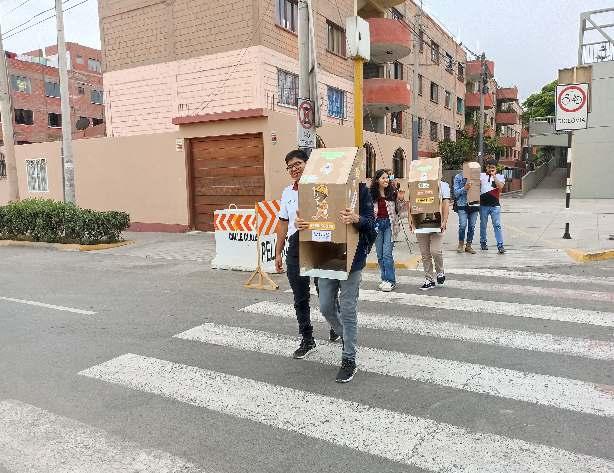
12 REVERSE PERISCOPE COMPANION
Using the periscope companion guide, they led three tours. In the first tour, students observed the route as independent adults, drawing, taking photos, or writing their impressions on the activity cards. On the second and third tours, pairs of students took turns using the periscope. One of the students experienced the route from a child’s perspective, and the other escorted them, experiencing the route as a caregiver.

The workshop concluded with a brief discussion and closing remarks. Comparing their impressions from each tour, students noted a change in their observations when they used the periscope to experience the street from the eye level of children. For example, students felt that as kids, they experienced the street as much more dangerous, feeling compelled to hold on to their “caregivers”. They reported that they felt surrounded by “huge walls” while using the periscope. Noisy motorcycles and elevated traffic lights made crossing the street challenging and scary. With their vision restricted as children, they became more sensitive to the smell of flowers and also to that of roadside waste.
This was an eye-opening experience for students. For some, it was the first time they considered their responsibility as future engineers to design safer, more convenient, and more attractive Streets for Kids. Building the periscope and using it to reflect on children’s route to school was a first-hand experience they will carry with them in the future, in their roles and projects.

Acknowledgments:
Road Safety Division of the Municipality of Lima: Milagros Ramos La Torre, Valeria Carrión, Guillermo Pilares and Jimena Bernabé. Anidare Organization: Andrea Loyola. Special thanks to student participants from the Pontificia Universidad Católica del Perú.

13 REVERSE PERISCOPE COMPANION
Photos: the Road Safety Division of the Municipality of Lima
CITIES SHARE STORIES CASE STUDIES
Bogota, Colombia (2022)

Despacio, a non-profit research center based in Bogota, used the periscope to experience the streets through the eye level of children. After assembling the tool from old cardboard boxes, mirrors, and tape, the team explored their surroundings, evaluating how interesting and safe the streets are for young children.
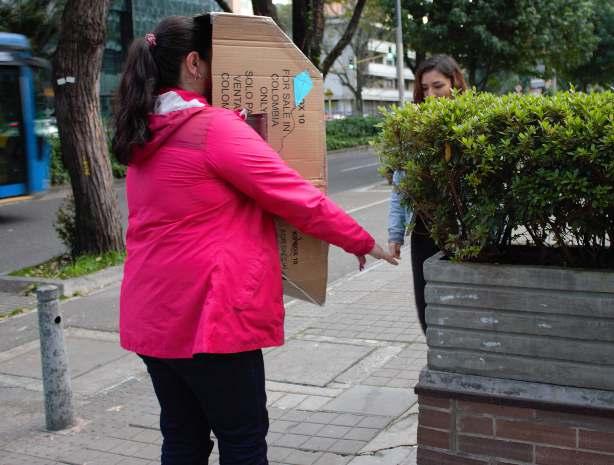
Using the periscope, they found familiar street elements, such as traffic signs, crossings, cars, and even the ground, increasingly exciting.
“In the activity cards, we were asked to observe the street for playful
14 REVERSE PERISCOPE COMPANION
elements. At first, we didn’t understand - should we go to the park? But once we looked at the street through the periscope, from the eye level of children, everything appeared as a game. The street seemed like a big toy!”.

It was both thrilling and dangerous. On the one hand, as kids, they now saw familiar elements such as bike racks and potholes as exciting and worth exploring. On the other hand, children might catch their caregivers off guard as they surprisingly choose to explore potentially dangerous street elements, putting them in harm’s way.
The team also noted how differently they experienced movement on the street from the perspective of children. Ordinary cars now seemed huge and fast, bicycle riders quick and blurry, and SUVs looked like “monster tracks”. Using the periscope also limited their ability to estimate speeds and distances. Routes that were usually short and familiar became long and challenging. With these new obstacles, they also recognized how certain design elements, such as unique tile patterns and planters, were helpful wayfinding tools.
In their work, Despacio focuses on the well-being of community members at different life stages. So, while the periscope was developed to explore children’s needs, it also helped them consider other points of view, such as people with short stature or using a wheelchair. They reflected on the legibility of elevated street signs and how differently they felt when walking on a slow street, a street with wide sidewalks and bike routes, and a busy main street with public transportation. “The periscope was a very helpful tool to experience different perspectives,” they concluded. “It was also great fun and a good team-building exercise. We’ll be sure to use it again”.
Acknowledgments:
Despacio: Camilo Urbano, Angie Ángel, Maria Fernanda Ramírez, and Lina Marcela Quiñones.
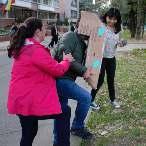
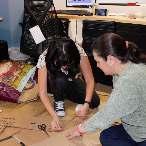
Photos: Despacio
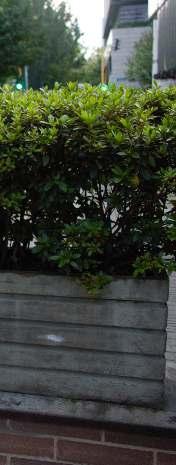
15 REVERSE PERISCOPE COMPANION
WRAPPING UP IDEAS TO INSPIRE FUTURE ENGAGEMENT
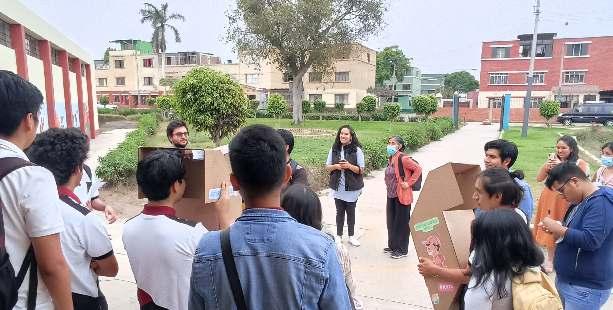
Using the periscope could be a great conversation starter to discuss the importance of planning for young children and their caregivers and the key mobility challenges they face. In our experience, it is helpful to introduce prompts at different stages of the activities. For example, you may want to sensitize participants during introductions by asking them to recall their childhood experiences or those of the people they love. During the activity, questions may help to encourage reflections on existing perceptions. A share-out can highlight differences and similarities in experiences. Here are some prompts you may like to use:
• Picture your favorite place to play as a child. Was it indoors or outdoors? Supervised or unsupervised?
• Today, how much time does it take for your kids or others to get to a play area? What mode of travel do they use?
• What most surprised you about your experience using the periscope? Would you like to share some of the elements you noted on your cards?
• Following your experience, If you could change the site, what would you change about it? What would you keep or enhance?
• Is there something you learned through this exercise that made you reflect on your own work or everyday life?
Photo: The Road Safety Division of the Municipality of Lima.
KEEP THE CONVERSATION GOING
The walkshop activity cards could be easily packaged to illustrate your activity in an accessible before and after format. Comparing cards that participants filled out as adults and those they filled out from the eye level of young children is an effective tool to communicate the needs of children to the group and to external partners. An open template is available by clicking the icon below. To use the template, please copy the file before making edits.
An illustration of how walkshop cards may look after being filled out.
The Streets for Kids team is always interested to learn how our tools are being used in cities across the world. Use the hashtag #StreetsForKids and #Periscope to share your experience and connect to a global network of changemakers working to create better streets for kids. You can also contact us at sfk@gdci.global

17 REVERSE PERISCOPE COMPANION
About the Streets for Kids program
GLOBAL DESIGNING CITIES INITIATIVE (GDCI)
Global Designing Cities Initiative (GDCI) focuses on inspiring a shift toward safe, sustainable, and healthy cities through transforming urban streets. We are committed to raising the state of the practice for street design and sustainable transportation around the world by developing new technical guidance and resources, building a common vision, sharing data, encouraging peer-to-peer exchanges, and supporting regular communication among international cities.
Based on the award-winning Global Street Design Guide (GSDG) publication, which set a new global standard for designing urban streets that prioritize pedestrians, cyclists, and transit riders, GDCI provides technical assistance to cities around the world. GDCI helps cities apply the practical strategies from the GSDG to local contexts, simultaneously addressing challenges such as climate change, road safety, and public health.

STREETS FOR KIDS PROGRAM
Streets for Kids aims to inspire leaders, inform practitioners, and empower communities to make cities around the world better for children and their caregivers.

Streets for Kids, a program of GDCI, looks at cities through the lens of children and their caregivers. Designing Streets for Kids, a child-focused design guide to supplement the GSDG, was published in 2020. GDCI applied child-focused strategies in 12 cities through streetscape transformations, workshops, and trainings. Four cities—Fortaleza, Brazil; Kigali, Rwanda; Santiago, Chile; and Tirana, Albania—were selected for in-depth technical assistance and training. Eight additional cities were awarded in-depth virtual training to advance childfocused street design.
In 2022, GDCI delivered the first Streets for Kids Leadership Accelerator, which built upon the successes of the program to date. The Leadership Accelerator brought together 60 changemakers from 20 cities worldwide to participate in an six-month virtual professional leadership program. The program also included the start of several self-paced online training courses open to industry practitioners.
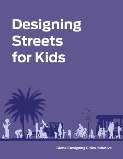
18 REVERSE PERISCOPE COMPANION
Photo: Fortaleza, Brazil (Paulo Winz).
Focus of the Streets for Kids program
Streets for kids Improved
DESIGNING FOR CHILD-FRIENDLY STREETS
GDCI’s goal is to work directly with practitioners to reimagine and redesign their streets to support comfortable, healthy, and inspiring environments for all children.
The goals of the Streets for Kids program are to:
• Catalyze the implementation of street designs that support sustainable mobility choices and quality public spaces that advance the well-being of children and their caregivers
• Provide child-focused guidance on street design and policy
• Build local capacity through trainings and give participants an expanded toolkit to create streets that are safe, enjoyable, and inspirational
• Train practitioners to help envision great streets for kids and see what’s possible in cities
19 REVERSE PERISCOPE COMPANION
and
Spaces to pause and stay
independent mobility
Program funders

We are grateful to our funding organizations for their support and enthusiasm for Streets for Kids.
BERNARD VAN LEER FOUNDATION

Bernard van Leer Foundation believes that giving all children a good start in life is both the right thing to do and the best way to build healthy, prosperous and creative societies.
FONDATION BOTNAR

Fondation Botnar is investing in emerging solutions to build a better future for children and young people globally.
FIA FOUNDATION
The FIA Foundation is a leading global road safety philanthropy, enabling innovative injury prevention programmes and pilot projects.
REVERSE PERISCOPE COMPANION 20
GDCI is excited to work with you and your city to reimagine, rethink, and redesign streets for kids!
FOR FURTHER QUESTIONS, PLEASE CONTACT: SFK@GDCI.GLOBAL
REVERSE PERISCOPE COMPANION 21
REVERSE PERISCOPE COMPANION 22























